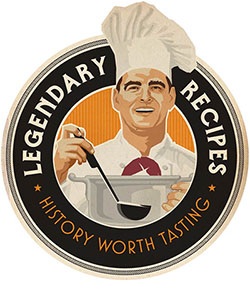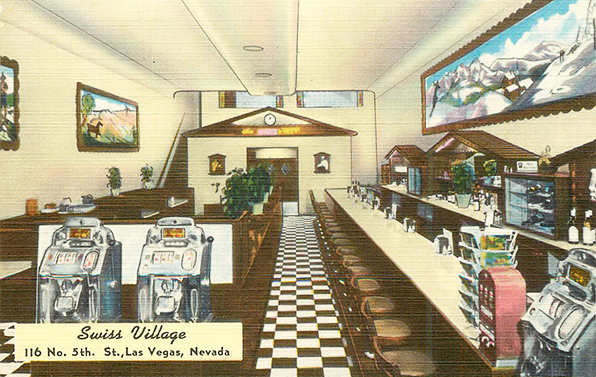In the mid-1920s Walter Fredrick Wolfinger left his family in Switzerland to come to the United States and pursue his career as a chef, which before long would bring him to the fast-growing city of Las Vegas. Back then a big sign was strung across Fremont Street that read “Welcome to Las Vegas—The Gateway to Boulder Dam,” the massive federal construction project that had made the little railroad town Depression-proof. By the time the dam was officially rechristened Hoover Dam in 1947, Las Vegas was well on its way to way to becoming a gambling mecca.
In 1941 the city’s first hotel-casino, El Rancho Vegas, had opened on a stretch of Highway 91, the two-lane road that led all the way to Los Angeles. Five years later Guy McAfee, the proprietor of the Golden Nugget casino, nicknamed this area, directly south of the Las Vegas city limits, “The Strip.” Meanwhile, other hotel-casinos sprouted up on Fremont Street, which the Las Vegas Chamber of Commerce promptly dubbed “Glitter Gulch.”
Wolfinger, called into the U.S. military during World War II, spent two years as a steward on the S.S. Clark Howell, one of the 2,711 “liberty ships” built by the U.S. Maritime Commission for wartime service. On returning to Las Vegas Wolfinger easily found work, and in 1944 the 38-year-old chef found a bride: Ruby Wilma Johnson, six years younger. The newlywed couple briefly operated a cafe on South 5th Street, and in 1945 Wolfinger took charge of the dining room at the The Players, a supper club on Highway 91, which billed him in its newspaper ads as a “World Famous Chef.”
But the Wolfingers clearly had greater ambitions, and on August 9, 1946, they opened the Swiss Village in a two-story building at 116 North Fifth Street that had once housed a construction company. (In 1959 Fifth Street would be renamed Las Vegas Boulevard.) They’d hired Richard Porter of Desert Designers to decorate the 100-seat restaurant, and he came through by painting large murals featuring famous Swiss scenes (including one of the Matterhorn) for the walls, installing glass-fronted “chalets” on the backbar behind the counter, and building an “Edelweiss Room” for private parties on a mezzanine above the kitchen. The waitresses wore Tyrolean costumes. The slot machines in the front of the restaurant didn’t exactly fit the restaurant’s Swiss theme, but no matter—they gave patrons something to do with their spare change.
Just months after the Swiss Chalet opened Wolfinger offered a special Thanksgiving dinner with these entrees: Roast Young Tom Turkey with Cornbread Dressing, Cranberry Sauce, and Giblet Gravy ($2.75); Baked Sugar-Cured Ham with Champagne Sauce ($3.00), and a New York Cut Sirloin Steak with Mushroom Sauce ($3.50). The dinner included an assortment of salted nuts, hearts of celery, scallions, radishes, and California fruit cocktail; cream of tomato or onion soup; a mixed green salad with French dressing; sweet potatoes; succotash or creamed pearl onions; and, for dessert, hot mince pie with brandy sauce, pumpkin pie, fresh strawberry cream pie, or fresh fruit.
In 1947 Wolfinger traveled to Switzerland to see his family for the first time in 21 years. Wilma didn’t go with him. An account of his trip in the Las Vegas Review-Journal noted that she had been “stricken with illness at the last moment and canceled her plans to go with her husband,” adding that “the couple plan another trip in the spring together.” But that may not have been the real story, as the following year Wilma was granted a divorce from Walter, who made no appearance in court. In a property settlement dated December 22, 1947, Wilma was given possession of the Swiss Chalet; Walter retained possession of a car and $1,000.
Soon after that Wilma sold the Swiss Village to Howard W. Gale, who brought in Paul Lollar to be its chef. Lollar made no radical changes in the menu. His 1951 Thanksgiving Day dinner menu, for example, included many of the same items that were among Wolfinger’s offerings five years earlier, from a “California Fruit Cup Grenadine” to the “Hot Mince Pie with Brandy Sauce.”
In 1952 Harry Farnow and Joe Schramm hired Wolfinger to be the chef of their new restaurant, Duffy’s Tavern, where he directed an open kitchen that was entirely visible to the patrons. Wolfinger, who’d remarried in 1949, didn’t stay long. Sometime that year he was back in the saddle at the Swiss Chalet with his second wife, Marion. They operated the Swiss Village until 1954, when the restaurant quietly closed its doors. The following year, after extensive renovations and remodeling, Bob Baskin and Garland Miner, the former operators of the Round-Up Drive In, opened Bob Baskin’s Restaurant in the same space.
Walt and Marion Wolfinger then moved to Cedar City, Utah, where in 1956 he bought Milt’s Stage Stop, a beer-and-sandwich place on Highway 14, and turned it into a family restaurant that served steaks and seafood. Four years later he opened a second restaurant, Walt’s Dinette, on South Main Street. He died in 1984 at age 78.

Plum Pudding
Walter F. Wolfinger, who opened the Swiss Village Restaurant in Las Vegas in 1949, liked to create elaborate menus for the special holiday dinners he served at the restaurant on Thanksgiving and Christmas Day. This dessert, which was billed as "Our Own Plum Pudding" on the Christmas dinner, was typically served with a hard sauce.
Ingredients
- 1 to 2 tablespoons unsalted butter, softened
- 3/4 cup whole milk, scalded
- 3/4 cup graham cracker crumbs
- 3/4 cup sifted all-purpose flour
- 1 teaspoon salt
- 1 teaspoon baking soda
- 1 teaspoon ground cinnamon
- 1/2 teaspoon ground mace
- 2 3/4 cups currants
- 3/4 cup finely chopped candied lemon peel
- 3/4 cup finely chopped candied orange peel
- 3/4 cup chopped walnuts
- 4 eggs, separated, at room temperature
- 1 cup packed brown sugar
- 1/2 cup cherry jelly or preserves
- 1/4 cup apple juice
- 1/2 pound finely chopped or shredded unrendered beef suet
Instructions
Generously grease a large pudding basin or ovenproof bowl with the softened butter; set aside.
In a small bowl, gently pour the scalded milk over the graham cracker crumbs to soak them.
Sift together the flour, salt, baking soda, cinnamon, and mace. Add the lemon and orange peel and walnuts and stir until coated.
Using an electric hand mixer, beat the egg whites on medium-low until the mixture looks frothy, 1 to 2 minutes. Slowly increase the speed to medium-high. Continue to beat the egg whites until soft peaks form, about 3 minutes. Set aside.
In a separate bowl but using the same mixer, combine the egg yolks and brown sugar and beat until the mixture is light and fluffy, about 3 minutes. Add the suet and soaked graham cracker crumbs. Gently fold in the flour, fruit, and nut mixture, Add the cherry jelly or preserves and apple juice and stir until well-blended.
Using a spatula, gently fold the beaten egg whites into the pudding mixture until the batter is evenly smooth.
Spoon the pudding batter into the prepared basin or bowl, filling it no more than 2/3 full. Cover with buttered parchment paper and foil, tying kitchen string around the rim to make a tight seal.
Place a metal jam-jar lid or trivet in the bottom of a stockpot. Place the pudding basin on top of the lid and fill the pot with enough hot water to come halfway up the side of the pudding basin. Bring the water to a gentle boil; steam pudding, covered, for 3 1/2 hours, or until it is a rich, dark brown and a wooden skewer inserted into the middle comes out clean.
Carefully remove the pudding from the stock pot; let stand 5 minutes before unmolding.
Notes
Serve, if desired, with hard sauce.
In Our Vault: More Recipes from Swiss Village Restaurant
- Swiss Veal Sauté










No Comments